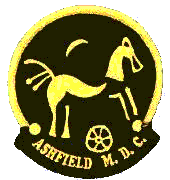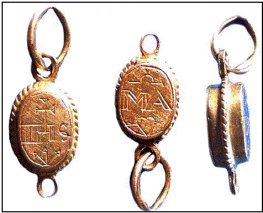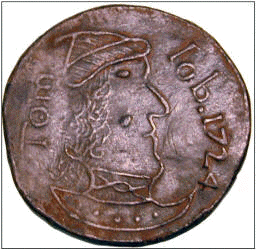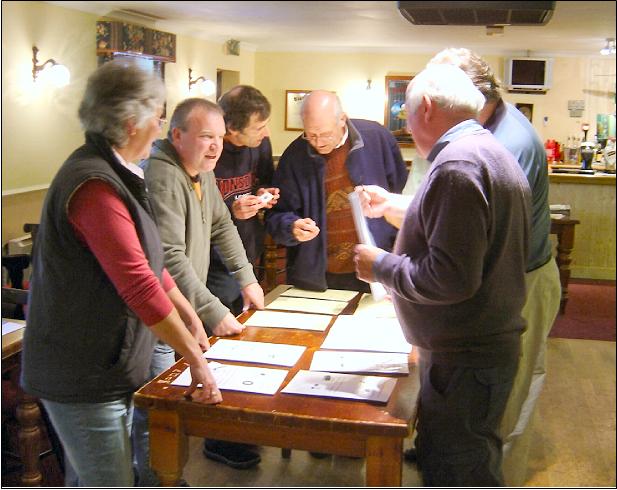|

| |
Time Team Detectorists
|
|
Jonathan Smith |
 |
David Hallam |
Obverse
 |
Reverse
 |
At the January Club Meeting
A nice surprise for club members at the January meeting was a visit by Jonathan Smith
the finder of the Gold Noble of Henry V on the Time Team dig at Codnor Castle in Derbyshire.
He is shown in the picture with Ashfield Club member, David Hallam, his partner in grime
at the excavation. It is understood that the coin will eventually be presented to a local
museum for display. This was the first gold coin to be found while making a Time Team
programme. As a consolation David Hallam found a silver penny of Alexander III of Scotland
which he had great difficulty in persuading Phil Harding, who was in charge of
David’s trench, that it was in fact a Scottish coin!
|
Find Of The Month November 2007
|
| Artefact |
Coin |
 |
Medieval
Beehive
ThimbleFound by
John Radford
|
 |
Titus 79-81 AD
Roman Silver DenariusFound by
John Radford
|
Find Of The Month December 2007
|
 |
Artefact Joint
Winners |
 |
|
Celtic Horse Cheek Piece |
|
Found By John Radford |
|
Found By John Wardle |
| A report of their exciting find can be read below |
| |
Coin |
|
 |
Roman Republican Silver Denarius
Found By
Bill French |
 |
Other Finds Placed On TheTable
|
 |
 |
|
 |
 |
Charles 1st.Sixpence 1643
Found By Bill French |
|
Edward VII 1909 Silver Florin
On the reverse is Britannia Standing
This nice coin was found by Dennis Brown |
Find Of The Month January 2008
|
| Artefact |
Coin |
 |
 |
 |
| Roman Brooch Found
By John Wardle |
Henry III
Silver Penny - Canterbury Mint Found By John Radford |
Other Finds Placed On TheTable
|
 |
Both these artefacts, a medieval heraldic horse pendant and a medieval buckle, were found by Dennis Brown.
The heraldic horse pendant shows signs of being gilded and the buckle has traces of solder on the toothed end.
|
 |
 |
Henry VI silver hammered halfpenny
Mint mark London
Found by David Hallam
|
 |
 |
Queen Victoria Penny
This 1877 ‘Viccy penny’ was found by Dennis Brown
It is in a remarkable state of preservation with a beautiful patina
|
 |
| Gold Religious Pendant |
|
Duncan Walters |
 |
Newark Museum has shown an interest in obtaining the gold religious pendant found by
Duncan Walters on a club search in July, 2007.
The pendant was awarded the August, 2007, club artefact Find of the Month.
|
 |
The Magpie's Companion By Steven Banks
|
 |
|
In the Summer 2007 issue of this newsletter I featured a book, The Magpie’s Companion by Steven Banks
in which the author described metal detectors as illegitimate offspring of the soldier’s mine detector.
The use of this bastard device should be illegal except for special licence. The article was included
on the club website and in response to this I received an email from Elizabeth Berreen :-
’Fascinated to read your comments on the Magpie’s Companion. Glad it is still being read!
Steven Banks was my Uncle and I am familiar with his opinions of metal detectors. He was Captain Henry
John Steven Banks RN and had a distinguished career in the navy. He served in
Ark Royal with the Fleet Air Arm and was Naval attaché in Turkey in the
late 1950’s. He died aged 85 in 1999.
He did some research for Magpie while staying with us and I remember reading it when it
came out. I told him it was good timing as metal detectors were relatively new and the
craze was only just starting, his reply would take a few xxxx’s to repeat! He has
written other books including Handicrafts of the Sailor and he was a great authority
on pottery, especially Lustre Ware’.
Elizabeth Berreen kindly allowed the club to use the photograph of
Steven Banks which was taken in the 1960’s.
|
|
Steven Banks |

Bill French In Action
The last of the 'Thin Red Line' or has Santa
lost his jacket ! |
|
Unusual Horse Shoe |
| Most metal detectorists try to avoid finding horse shoe, however club member Susan Toone is just the opposite. She collects them!
|
 |
|
The one shown here puzzled Susan when she found it and she decided to research it.
She contacted Paul Cottam of Arthur Cottam and Co., Horseshoes Ltd.
He replied:- ‘The shoe may have been used due to the horse having a disease called Navicular
and the plate underneath supports the part of the hoof below the penal bone and prevents it
moving out of line and laming the animal’.
|
|
Books |
 |
|
In this newsletter I would like to introduce you to a book I bought in 1992. It is number 3 in the Medieval
Finds from Excavations in London series, Dress Accessories c. 1150 — c. 1450 by Geoff Egan and
Francis Pritchard. Museum of London. HMSO. The book is described as ‘ Brooches, rings, buckles, pendants,
buttons, purses and other accessories were part of everyday dress in the Middle Ages. This
book describes and discusses over 2,000 such items dating from the period 1150-1450 and found
in recent archaeological excavations in the City of London………...show the popularity of shoddy,
mass-produced items made from base metals during the high Middle Ages……….Anyone needing
accurate information on period costume will welcome this book, which will appeal the
general reader interested in costume and design as well as to archaeologists’.
Not forgetting metal detectorists !
The edition I have is paperback, 410 pages with 1,784 illustrations and cost £39.95 in 1992.
I have found two copies for sale on the internet, they are both ex-library editions, the cheapest is £51.
|
Metal Detecting Abroad |
|
Some of us will be lucky enough to holiday abroad this year. If so, and you intend to take
your detector please acquaint yourself with the laws of the country you are visiting.
Especially Greece and Turkey both them are a no, no, and have Draconian laws against the hobby,
even on beaches. I have had no problems in Spain, Portugal or Cyprus but I have only
detected on beaches and never inland.
This is a picture of someone who shall be nameless recovering his digging tools from Pissouri Bay,
Cyprus after hiding them one year to recover and use the next. The reason for this was to save
baggage weight on the homeward flight to make space for more important things like booze!
|
|
 |
 |
 |
3. All coins from the same find provided they are at least 300 years old when found (but if
the coins contain less than 10 per cent of gold or silver there must be at least ten of them).
Only the following groups of coins will normally be regarded as coming from the same find:
1. hoards that have been deliberately hidden.
2. smaller groups of coins, such as the contents of purses, that may been dropped or lost.
3. votive or ritual deposits.
|
4. Any object, whatever it is made of, that is found in the same place as, or had previously been together with, another object that is Treasure.
|
5. Any object that would previously have been treasure trove, but does not fall within the
specific categories given above. Only objects that are less than 300 years old, that are made
substantially of gold or silver, that have been deliberately hidden with the intention of
recovery and whose owners or heirs are unknown will come into this category.
Note: An object or coin is part of the ‘same find’ as another object or coin if it is
found in the same place as, or had previously been together with, the other object.
Finds may have become scattered since they were originally deposited in the ground.
What should I do if I find something that may be Treasure? You must report all finds of
Treasure to a coroner for the district in which they are found either within 14 days after the
day on which you made the discovery or within 14 days after the day on which you
realised the find might be treasure. Your local Finds Liaison Officer will be able to help you
with each stage of the process.
|
|
Single Gold or Silver Coins |
What Is Not Treasure ?
Single Bronze Age Objects |
Rings Under 300 Years Old |
 |
 |
 |
The photographs in this article are only a representative sample and can only be a basic guide to what might be considered Treasure.
Liz Andrews-Wilson, Portable Antiquities Scheme, Finds Liaison Officer for North East Yorkshire has kindly given permission for this article to be reproduced.
|
|
|
|
John Radford |
 |
John Wardle |
 |
 |
 |
Iron Age/Celtic Horse Cheek Piece
Found by John Radford
On a dismal, cold and foggy day in December, the club held a search on a North Nottinghamshire field.
Ten members out of the total club membership of thirty braved the elements on a field that had not been
too productive in the past, although Roman bronze coins of Constantine and Carausius had been found.
An incentive for some of the searchers was the possibility of finding current coinage deposited on
the field in sweepings and biodegradable refuse from a nearby children’s attraction.
It was bitterly cold and one of the searchers, John Radford, decided to stay near to where he had
parked his car and close to his Thermos flask of hot coffee. As is usual on a club search most
detectorists head for the centre and the end of the field furthest away from the start,
so John found himself on his own with nearly half the field as his oyster. Not long into the
search he recovered a small plain modern 9ct. gold ring and as the morning progressed a lead
token, pound coin, George III penny and various buttons came to light.
As John was detecting back towards his car for lunch he found a bronze object with enamelled
markings on it, he thought it was a pipe tamper and as such worth putting in his keepers bag. At
lunch when most of the detectorists gathered to discuss the results, or lack of results,
of the morning search, John showed his ’pipe tamper’ to the group and John Wardle
produced a nearly identical object with similar markings on it. When they compared the two
objects it became apparent that they belonged together. Speculation then ensued as to the purpose
of the artefact and suggestions ranging from a Victorian gas tap to a dagger handle were
proposed, the ’pipe tamper’ identification had been discarded.
John Radford took both halves home with him to photograph. After consulting various books he arrived
at the conclusion that it was a Celtic horse cheek piece and later the UKDFD confirmed it as being
an Iron Age / Celtic horse cheek piece that was thought to have been attached to either end of the
bridle bit. Similar ones had been excavated from late Iron Age chariot burials. The two halves had been
found within a few hours about 200 yards apart. The entire cheek piece was declared to Anja Rohde,
the Finds Liaison Officer at the January club meeting for recording. Incidentally the whole cheek
piece won the December, artefact Find of the Month as a joint award.
Both finders use Minelab Explorers as their main machines. It is noticeable that since John Radford
has changed his machine to an Explorer the number of his finds, especially good ones, has shot up,
a quick glance through recent newsletters will confirm this. (If only Explorers weren’t so heavy.)
John Radford has written a more detailed account of this extraordinary find for an issue of the
Searcher magazine that is due to be published soon.
|
 |
|
This magnificent lead token was found (not on a club site) by a club member, Nigel Warren,
in a North Nottinghamshire field, near Retford. The token measures 4cm x 2.2cm., and weighs 22.7g.
The inscription is ‘Tom Lob (or Job’ 1724’. It is possible that the name refers to a West
countryman who moved to Nottinghamshire after the Monmouth Rebellion. However more research has
to be done. The token will be featured by David Powell in a future issue of the Lead Token Telegraph
|
Great Seal Of The King Of England
Henry I. 1100-1135
|
 |
Find Of The Month
|
 |
'Eyes Down Look In'
Find of the Month entries being closely scrutinised at a club meeting
|
Written by John Gough |
